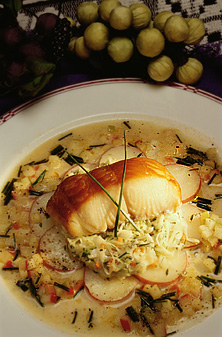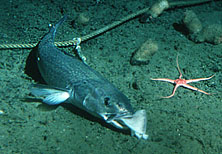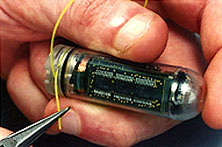Sablefish (Black Cod) (Anoplopoma fimbria)
- Sablefish population levels are high, and no overfishing is occurring.
- Alaskan sablefish are managed using individual fishing quotas (IFQs) which assign a quota to individuals and seek to provide some ownership of the resource to Alaskan communities.
- Sablefish is rich in omega-3 fatty acids. For more information, see Nutrition Facts. (USDA)
- Sablefish are the highest valued finfish per pound in Alaska and Pacific Coast commercial fisheries. The majority of sablefish consumed in the U.S. is smoked.
|
 |
 |
 |
 |
| Nutrition Facts |
| Servings 1 |
| Serving Weight
100 g |
 |
| Amount Per Serving |
 |
| Calories 195 |
 |
| Total Fat |
15.3 g |
 |
| Total Saturated Fatty Acids |
3.201 g |
 |
| Carbohydrate |
0 g |
| Sugars |
0 g |
| Total Dietary
Fiber |
0 g |
 |
| Cholesterol |
49 mg |
 |
| Selenium |
36.5 mcg |
 |
| Sodium |
56 mg |
 |
| Protein |
13.41 g |
 |
|
 |
 A sablefish being measured during a research survey.
A sablefish being measured during a research survey.
|
 |
Did you know?
Sablefish have been known to live longer than 90 years; in fact, the oldest sablefish found was reported to be 114 years old.
Sablefish have a rich oil content which makes it exceptionally flavorful and, thus, a highly valuable commercial species. In fact, sablefish are the highest valued finfish per pound in Alaska and Pacific coast commercial fisheries.
Sablefish are often referred to as a black cod but are not actually part of the cod family. They resemble cod but are part of the Anoplopomatidae family, a group of fishes confined to the North Pacific Ocean.
|
|
| |
 |
|
Adult sablefish typically live in water deeper than 650 feet but have been found as deep as 9,840 feet.
|
 |
|
Electronic tag implanted in sablefish.
|
|
Sustainability Status
Biomass: Pacific coast sablefish is at 96% of the biomass needed to support maximum sustainable yield (BMSY); the sablefish population in the Bering Sea/Aleutian Islands (BSAI) is 5% above BMSY.
Overfishing: No
Overfished: No
Fishing and habitat: The major fishery for sablefish in Alaska uses longlines; the effects of longline gear on bottom habitat are poorly understood. Sablefish are also caught in fisheries that use bottom trawl gear, which are prohibited in certain areas to protect sensitive habitats. Off the west coast, trawl and longlines are equally used to catch sablefish.
Bycatch: There can be a significant bycatch of spiny dogfish and other sharks and grenadier in sablefish fisheries. Seabirds may also be captured, although this is decreasing due to widespread use of measures to reduce seabird catch.
Aquaculture: There is currently no commercial aquaculture of sablefish in the U.S., but research on sablefish aquaculture is ongoing.
|
Science and Management
Two populations of sablefish have been identified based on differences in growth rate, size at maturity, and tagging studies. A northern population inhabits Alaska and northern British Columbia waters, and a southern population inhabits southern British Columbia and Washington, Oregon, and California waters, with mixing of both populations occurring off southwest Vancouver Island and northwest Washington. Sablefish are assessed as a single population off Alaska; this population is managed through the North Pacific Fishery Management Council's (NPFMC) Gulf of Alaska (GOA) and Bering Sea/Aleutian Islands (BSAI) Groundfish Fishery Management Plans. There are four management areas in the GOA: Western, Central, West Yakutat, and East Yakutat/Southeast Outside (SEO) and two management areas in the BSAI: the eastern Bering Sea and the Aleutian Islands region. Management measures include total allowable catch (TAC) apportioned among gear types (trawl and fixed) and an individual fishing quota (IFQ) program for the majority of fixed gear. The sablefish fisheries off the coast of Washington, Oregon, and California are managed through the Pacific Fishery Management Council's (PFMC) Pacific Fishery Management Council’s (PFMC) Pacific Coast Groundfish Fishery Management Plan, approved in 1982. Trip limits were implemented in October 1982; since then, the sablefish fishery has been managed intensively to limit catches with limited-entry and open-access programs. Formal stock assessments have been coordinated through the Pacific Fishery Management Council (PFMC) since 1984.
There are also state fisheries established by the State of Alaska that land sablefish outside the IFQ program. Sablefish are occasionally caught in recreational fisheries during seasonal (i.e., summer) migrations onto the continental shelf.
|
Life History and Habitat
Life history, including information on the habitat, growth, feeding, and reproduction of a species, is important because it affects how a fishery is managed. There is limited information concerning the juvenile biology and post-larval stage of sablefish, which complicates assessing the extent to which stocks may exchange genetic material. Continued research is necessary to improve management of sablefish.
- Geographic range: From Japan, north into the Bering Sea and south through Alaska, to the southern tip of Baja, California; highest concentrations in Alaska
- Habitat: Sablefish are found in waters 656 feet or deeper and have been found as deep as 9,800 feet. Juveniles live in surface and near-shore waters; adults live on mud bottoms.
- Life span: Sablefish are long-lived and are estimated to live longer than 90 years. The maximum age reported is 114 years.
- Food: Small sablefish eat zooplankton (tiny floating animals) in their first weeks of life. Sablefish prey on crustaceans, worms, and small fish as they grow older.
- Growth rate: Rapid
- Maximum size: 4 feet
- Reaches reproductive maturity: Females mature at 2.1 feet and 6.5 years of age; males mature at 1.9 feet and 5 years of age.
- Reproduction: Eggs develop in deep water for about 2 weeks until they hatch. Larvae swim to the surface after they begin feeding. In southeast Alaska and British Columbia, juveniles appear in nearshore waters by fall.
- Spawning season: March through April in Alaska; January through March between California and British Columbia
- Spawning grounds: Usually in deeper water (984 to 2,300 feet) along the continental slope; depth is dependent upon location
- Migrations: Sablefish are highly migratory for part of their life; some juveniles have been found to migrate over 2,000 miles in 6 or 7 years.
- Predators: Predators include other fish, seabirds, sharks, and killer whales.
- Commercial or recreational interest: Commercial
- Distinguishing characteristics: Roundfish resembling cod
|
Role in the Ecosystem
Larval sablefish feed on a variety of small zooplankton ranging from larval copepods (crustaceans) to small amphipods (small, shrimp-like crustaceans). Juveniles feed primarily on macrozooplankton and micronekton. Older juveniles and adults appear to be opportunistic feeders, with food ranging from bottom invertebrates to fishes, squid, and jellyfish. Nearshore residence during their second year provides the opportunity to feed on salmon fry and smolts during the summer months. Young of the year sablefish are commonly found in the stomachs of salmon taken in the southeast Alaska troll fishery during the late summer.
|
Additional Information
Market name: Sablefish
Vernacular names: Black cod, Butterfish, Skil, Skilfish*, Beshow, Coalfish
Skilfish is the common name for Erilepis zonifer, which are often mistaken for sablefish
|
Biomass
 Biomass refers to the amount of sablefish in the ocean. Scientists cannot collect and weigh every single fish to determine biomass, so they use models to estimate it instead. These biomass estimates can help determine if a stock is being fished too heavily or if it may be able to tolerate more fishing pressure. Managers can then make appropriate changes in the regulations of the fishery. The sablefish fishery has been managed intensively to maintain levels of biomass. Biomass refers to the amount of sablefish in the ocean. Scientists cannot collect and weigh every single fish to determine biomass, so they use models to estimate it instead. These biomass estimates can help determine if a stock is being fished too heavily or if it may be able to tolerate more fishing pressure. Managers can then make appropriate changes in the regulations of the fishery. The sablefish fishery has been managed intensively to maintain levels of biomass.
Note: Alaska biomass only includes sablefish age 4 years and older. West Coast biomass includes sablefish 1 year and older.
Landings
 Landings refer to the amount of catch that is brought to land. Landings have been steadily declining since their peak around 1988. Since the approval of the FMPs that include sablefish, the fishery has been managed to limit catches with limited-entry, open-access, allowable biological catch, and optimum yield (OYs) programs on the Pacific Coast and with total allowable catch (TAC) and an individual fishing quota (IFQ) program off Alaska. Landings refer to the amount of catch that is brought to land. Landings have been steadily declining since their peak around 1988. Since the approval of the FMPs that include sablefish, the fishery has been managed to limit catches with limited-entry, open-access, allowable biological catch, and optimum yield (OYs) programs on the Pacific Coast and with total allowable catch (TAC) and an individual fishing quota (IFQ) program off Alaska.
Note: The landings presented are domestic commercial landings.
Biomass and Landings
 Are landings and biomass related? Landings are dependent on biomass, management measures in the fishery, and fishing effort. Are landings and biomass related? Landings are dependent on biomass, management measures in the fishery, and fishing effort.
Data sources:
Biomass from Status of the Sablefish Resource off the Continental U.S. Pacific Coast in 2007, Alaska Sablefish Assessment for 2008
Landings from NOAA's National Marine Fisheries Service (NMFS) Annual Commercial Landing Statistics Website using "SABLEFISH" as species and "ALL STATES"
|
Important Dates
1900s to early 1980s – Management is the responsibility of the individual coastal states
1930-1957 – Relatively small catches, averaging 1,700 metric tons (3.75 million pounds); limited to areas near fishing ports
1958 – Japanese longliners begin operations in the eastern Bering Sea; shift to Aleutian Islands region and Gulf of Alaska (GOA)
1978 – GOA Fishery Management Plan (FMP) is approved; has been amended over 60 times since
1982 – U.S. longline fishery expands in GOA; Bering Sea/Aleutian Islands (BSAI) FMP is approved and has been amended over 70 times since; Pacific Fishery Management Council (PFMC) FMP is approved and has been amended 20 times since
1985 – Amendment 14 to the GOA FMP allocates sablefish quota by gear type; bans use of pots
1988 – U.S. sole harvester of sablefish taken in Alaska (with minor exceptions); catches at peak
1990 – Amendment 13 to BSAI FMP allocates sablefish quota by gear type
1992– Regulatory amendment prohibits longline pot gear in Bering Sea; amendment removed in 1996
1994 – Amendment 6 to the PFMC FMP implements a license limitation program for vessels in the groundfish fishery
1995 – Amendment 20 to GOA FMP and Amendment 15 to the BSAI FMP establish IFQs for hook-and-line vessels
1997 – Regulatory amendment in GOA revises maximum retainable allowances for sablefish
2001 – Amendment 14 to the PFMC FMP implements a permit stacking program and a primary (non-derby) fishery for limited entry fixed gear vessels with a sablefish endorsement
|
Notes and Links
General Information:
NOAA Alaska Fisheries Science Center Sablefish Research
NOAA Alaska Fisheries Science Center Fisheries Behavioral Ecology Program Species of Interest - Sablefish
NOAA Alaska Fisheries Science Center Summary of Seabird Bycatch in Alaskan Groundfish Fisheries 1993-2004 (2006)
North Pacific Fishery Management Council Groundfish of the Bering Sea and Aleutian Islands Area: Species Profiles 2001
North Pacific Fishery Management Council Groundfish of the Gulf of Alaska: A Species Profile (1998)
Pacific Fishery Management Council Background on Groundfish
Fishery Management:
North Pacific Fishery Management Council Fishery Management Plan for Groundfish of the Gulf of Alaska (2006)
North Pacific Fishery Management Council Fishery Management Plan for Groundfish of the Bering Sea/Aleutian Islands Management Area (2005)
Pacific Fishery Management Council Pacific Coast Groundfish Fishery Management Plan for the California, Oregon, and Washington Groundfish Fishery as amended through Amendment 19 (2006)
Stock Assessments:
Status of the Sablefish Resource off the Continental U.S. Pacific Coast in 2007
Alaska Sablefish Assessment for 2008
|
| |
|



